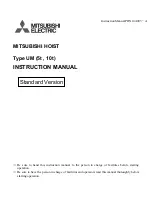
Model LR-416B, LR-165A, & LR-25B Hoist Installation and Operation Manual
Stock No. 036257
Page 8 of 22
NOTE:
The distance between the rear hinge shaft center and the saddle center is referred to as
the "M" dimension. In Figure 1, the "M" dimension for several dump angles are
tabulated.
NOTE
:
Moving the hoist rearward or forward along the truck frame will affect the hoist's
performance. A forward movement will reduce the dump angle and will increase
capacity while a rearward movement will increase the dump angle and reduce capacity.
NOTE:
If an obstruction can not be cleared by moving the hoist forward or rearward, the hoist
may be reverse mounted as shown in Figure 1.
4.
Slide each saddle bracket into the lower tube as shown in Figure 5.
5.
Locate the hoist on the truck frame, making sure to center the hoist right and left, and to square
the hoist with the truck frame. This hoist is designed to rest on the truck frame as shown in
Fig. #1. A small portion of the hoist extends below the truck frame level. The hoist may have
to be moved forward or rearward to avoid obstructions below the frame level.
6.
Slide a lock collar onto each lifting shaft. Slide a lifting shaft with collar into each end of the
hoist lifting tube. See Figure 4.
FIGURE 5
7.
When the hoist is positioned, place a mounting angle under each side of the hoist saddle.
Secure each mounting angle to the truck frame by drilling two 17/32" dia. holes and installing
two 1/2" flange screws and two 1/2" flange nuts. Torque all 1/2” fasteners to 90 ft-lb. See
Figure 5
8.
Weld each saddle bracket to the corresponding mounting angle. See Figure 5.
NOTE:
Do not
weld the hoist or mounting angle to the truck frame.
)/$1*(187
)/$1*(%2/7
6$''/($66(0%/<
758&.)5$0(
02817,1*$1*/(
758&.)5$0(





























